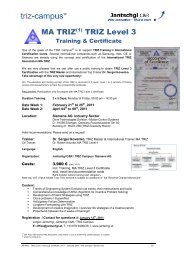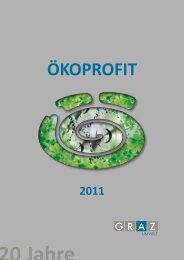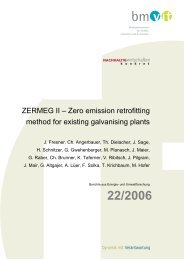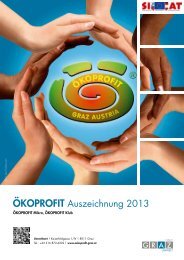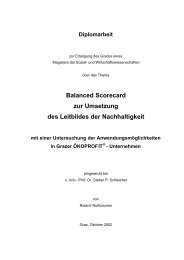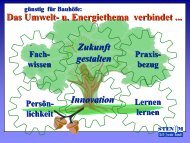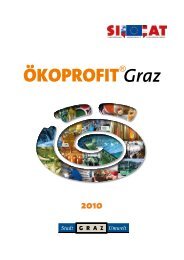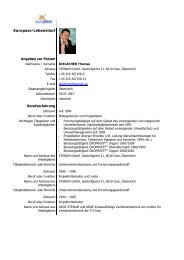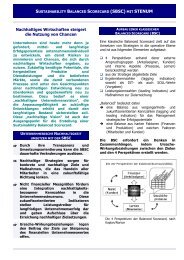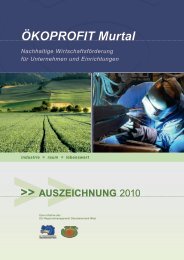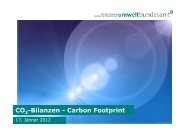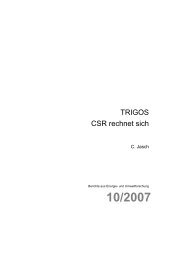Promoting Resource Efficiency in Small & Medium size ... - UNEP
Promoting Resource Efficiency in Small & Medium size ... - UNEP
Promoting Resource Efficiency in Small & Medium size ... - UNEP
Create successful ePaper yourself
Turn your PDF publications into a flip-book with our unique Google optimized e-Paper software.
3.4 Check<br />
In the ‘Check’ phase, performance <strong>in</strong>dicators are established and monitored<br />
and data is evaluated. It is good practise to document the old and<br />
the new situation for evaluation and learn<strong>in</strong>g. An example from a South<br />
Korean pa<strong>in</strong>t shop for TV frames is shown <strong>in</strong> Table 8.<br />
Specific water consumption =<br />
Water <strong>in</strong>put <strong>in</strong> 2009<br />
kg of product produced<br />
<strong>in</strong> 2009<br />
Project name: Install automatic pa<strong>in</strong>t gun<br />
Problem<br />
• Quality differs accord<strong>in</strong>g to the pa<strong>in</strong>ter<br />
• Pa<strong>in</strong>t is sprayed on walls and wasted<br />
Before<br />
Methodology<br />
• Install automatic pa<strong>in</strong>t gun<br />
• Spray <strong>in</strong> an up and down movement<br />
After<br />
Benefits<br />
• <strong>Resource</strong> <strong>Efficiency</strong>: 20% reduction of pa<strong>in</strong>t <strong>in</strong>put (about 4000 litres), less manual operator <strong>in</strong>volvement<br />
• Economical: 82,000 USD = Pa<strong>in</strong>t (32,000 USD) + reduced salary (50,000 USD)<br />
• Efforts: 130,000 USD<br />
Table 8: Before and after photos document<strong>in</strong>g action taken for resource- efficient<br />
pa<strong>in</strong>t<strong>in</strong>g <strong>in</strong> a pa<strong>in</strong>t shop pa<strong>in</strong>t<strong>in</strong>g TV frames.<br />
Indicators help to condense relevant data to provide exact and useful<br />
<strong>in</strong>formation about the efforts of management, the environmental impact<br />
of a company’s activities or the state of the environment. Benchmarks<br />
are chosen as a means to present quantity or quality data or <strong>in</strong>formation<br />
<strong>in</strong> an understandable and useful form. This <strong>in</strong>formation can be provided<br />
<strong>in</strong> the form of absolute or relative, normalised or <strong>in</strong>dicated <strong>in</strong>formation.<br />
In most companies, <strong>in</strong>dicators are already part of the plann<strong>in</strong>g process.<br />
Indicators can also be used <strong>in</strong> a similar way for an environmental<br />
<strong>in</strong>formation system to compile company data <strong>in</strong> a clearly structured way<br />
so that it is easy to <strong>in</strong>terpret.<br />
The follow<strong>in</strong>g types of <strong>in</strong>dicators can be used for controll<strong>in</strong>g <strong>Resource</strong><br />
<strong>Efficiency</strong>:<br />
Specific consumption<br />
Material <strong>in</strong>put, raw material<br />
A <strong>in</strong> kg <strong>in</strong> 2009<br />
Specific consumption, material A, 2009 =<br />
kg of product produced<br />
<strong>in</strong> 2009<br />
Waste B produced<br />
<strong>in</strong> kg <strong>in</strong> 2009<br />
Specific water generation, 2009 =<br />
kg of product produced<br />
<strong>in</strong> 2009<br />
Proportional values for present<strong>in</strong>g a part <strong>in</strong><br />
relation to the whole<br />
An example of a proportional value:<br />
Dr<strong>in</strong>k<strong>in</strong>g water proportion 2009 =<br />
Dr<strong>in</strong>k<strong>in</strong>g water <strong>in</strong>put<br />
<strong>in</strong> kg <strong>in</strong> 2009<br />
Water <strong>in</strong>put <strong>in</strong> kg <strong>in</strong> 2008<br />
Index figures compar<strong>in</strong>g identical figures over a<br />
course of time<br />
An example of an <strong>in</strong>dex figure:<br />
Water <strong>in</strong>dex 2009 =<br />
Water <strong>in</strong>put <strong>in</strong> 2009<br />
Water <strong>in</strong>put <strong>in</strong> the base year<br />
2007<br />
The <strong>in</strong>ternational standard ISO 14031 <strong>in</strong>cludes suggestions for how to<br />
select and formulate a benchmark<strong>in</strong>g study for your company.<br />
The International Organization for Standardization (ISO) describes two<br />
general <strong>in</strong>dicator categories:<br />
• Indicators for describ<strong>in</strong>g the environmental impact of an<br />
organisation<br />
– Indicators concern<strong>in</strong>g management systems<br />
– Process <strong>in</strong>dicators<br />
• Indicators for describ<strong>in</strong>g the condition of the environment<br />
26



